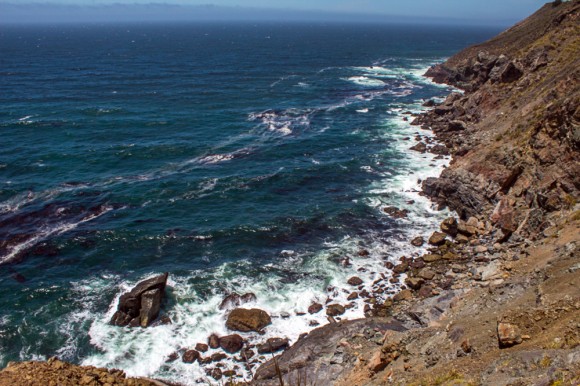
The Pacific Ocean crashes into the western coast off of Highway 1 in Big Sur, Calif. (Matt Sisneros/CU Independent)
“The Schanfar Side” is a weekly opinion column about the environment.
Opinions do not necessarily reflect CUIndependent.com or any of its sponsors.
Last week, scientists announced a startling discovery — orca whales can learn to “speak” dolphin in captivity.
Of the 10 captive orcas involved in this study, three who were housed with bottlenose dolphins made sound pitches more similar to a dolphin’s than another orca. This demonstrates not only the high level of consciousness of these amazing animals, but also the extreme intelligence they possess. But there is a deeper message here. If a creature we’ve been familiar with for years — beaten by SeaWorld for the last two decades — can surprise us so much, what else could possibly be lurking beneath the oceans we know so little about?
Further exploring the depths of the ocean should become a main priority of our species to further our own knowledge of the planet. Presently, over 95 percent of the ocean floor is unknown to man. In fact, we know more about the surfaces of Mars and the moon than we do about our own oceans. The jump from discovering that whales speak dolphin to advances in human science and resources seems extreme, but when one considers the implications of this vast unknown, the possibilities of what we stand to learn beneath the sea are limitless.
First, consider the implications of furthering our understanding of hypothermal vents on the ocean floor. Hypothermal vents are portions of the earth’s crust that have burst open to free hot, pressurized gasses from beneath the earth’s surface. When on dry land, they offer an enticing glance into an alternative energy source, given the extreme heat and movement associated.
But one must consider that the lowest points in altitude on the planet are beneath the sea, and as such, the hottest hypothermal vents are located miles underwater. By locating these vents, we can establish where the closest and most viable option for studies are, and perhaps find a new way to harness energy on a massive scale.
Another reason to consider traveling further under the sea is to find medical advances. Considering that over 7,000 medical compounds used by modern western physicists are derived from plants, plants on the floor of the ocean could also be worthy compounds for medical use.
With recent technological advances in drone technology, we have the capability to release a drone, unmanned, that could map the sea floors. Although it’d be a small push forward, releasing drones like this and focusing more efforts on underwater research would mark a necessary venture into a world unknown — a world that’s our own, but unlike anything we’ve come to be familiar with.
Contact CU Independent Staff Writer Sam Schanfarber at samuel.schanfarber@colorado.edu.
